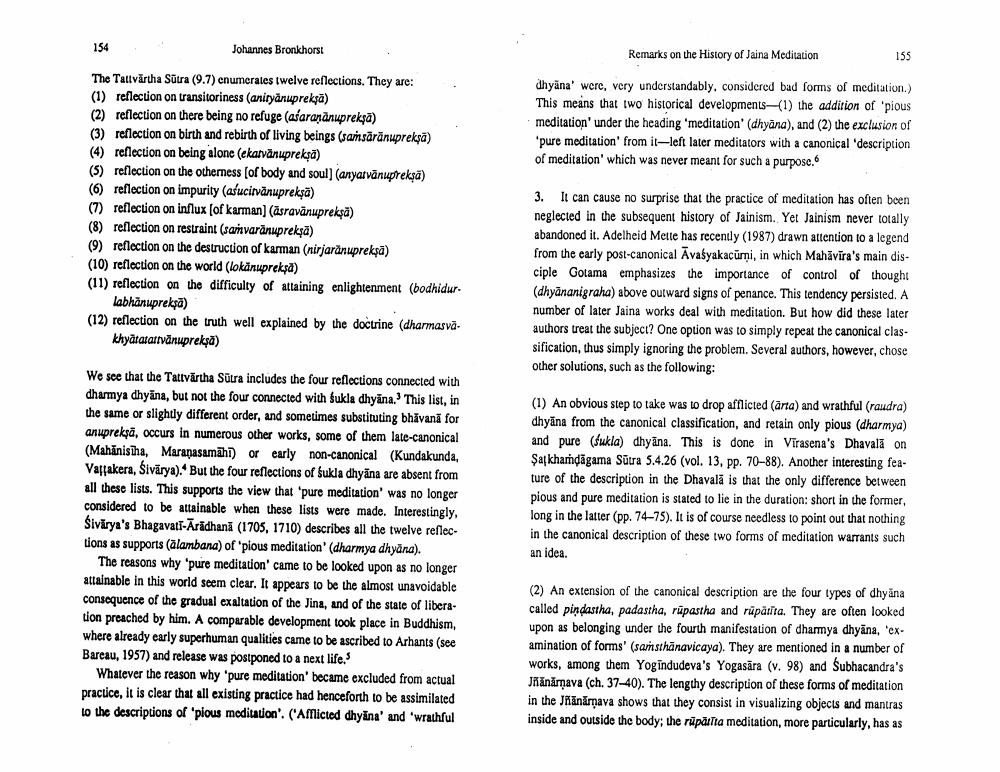Book Title: Remarks On History Of Jaina Meditation Author(s): Johannes Bronkhorst Publisher: Johannes Bronkhorst View full book textPage 3
________________ Johannes Bronkhorst Remarks on the History of Jaina Meditation 155 dhyāna' were, very understandably, considered bud forms of meditation.) This means that two historical developments-(1) the addition of 'pious meditation under the heading 'meditation' (dhyāna), and (2) the exclusion of 'pure meditation from il-left later meditators with a canonical 'description of meditation' which was never meant for such a purpose. The Tattvārtha Süura (9.7) enumerales twelve reflections. They are: (1) reflection on transitoriness (aniryarupreksā) (2) reflection on there being no refuge (asaranānupreksā) (3) reflection on birth and rebirth of living beings (samsārānuprekrā) (4) reflection on being alone (ekatvānupreksā) (5) reflection on the otherness (of body and soul] (anyatvānuprekça) (6) reflection on impurity (afucirvānupreksā) (7) reflection on influx (of karman) (äsravänuprekşd) (8) reflection on restraint (sarvarānupreksā) (9) reflection on the destruction of karman (nirjaranuprekça) (10) reflection on the world (lokānupreksa) (11) reflection on the difficulty of attaining enlightenment (bodhidur. labhānupreksā) (12) reflection on the truth well explained by the doctrine (dharmasva. khyātatattvänuprekşā) 3. It can cause no surprise that the practice of meditation has often been neglected in the subsequent history of Jainism. Yet Jainism never totally abandoned it. Adelheid Mette has recently (1987) drawn attention to a legend from the carly post-canonical Avasyakacūrmi, in which Mahavira's main disciple Golama emphasizes the importance of control of thought (dhyānanigraha) above outward signs of penance. This tendency persisted. A number of later Jaina works deal with meditation. But how did these later authors treat the subject? One option was to simply repeat the canonical classification, thus simply ignoring the problem. Several authors, however, chose other solutions, such as the following: We see that the Tattvārtha Süura includes the four reflections connected with dharmya dhyāna, but not the four connected with sukla dhyana. This list, in the same or slightly different order, and sometimes substituting bhāvanā for anuprekšā, occurs in numerous other works, some of them late-canonical (Mahānisia, Maranasamähn) or early non-canonical (Kundakunda, Vaffakera, Śivărya). But the four reflections of sukla dhyāna are absent from all these lists. This supports the view that "pure meditation was no longer considered to be attainable when these lists were made. Interestingly, Sivärya's Bhagavati-Ārādhanā (1705, 1710) describes all the twelve reflections as supports (alambana) of "pious meditation' (dharmya dhyana). The reasons why 'pure meditation came to be looked upon as no longer attainable in this world seem clear. It appears to be the almost unavoidable consequence of the gradual exaltation of the Jina, and of the state of liberation preached by him. A comparable development took place in Buddhism, where already early superhuman qualities came to be ascribed to Arhants (see Bareau, 1957) and release was postponed to a next life. Whatever the reason why 'pure meditation' became excluded from actual practice, it is clear that all existing practice had henceforth to be assimilated to the descriptions of 'pious meditation. (Afflicted dhyāna' and 'wrathful (1) An obvious step to take was to drop afflicted (arta) and wrathful (raudra) dhyana from the canonical classification, and retain only pious (dharmya) and pure (sukla) dhyāna. This is done in Virasena's Dhavalā on Satkhamdāgama Suva 5.4.26 (vol. 13, pp. 70-88). Another interesting feature of the description in the Dhavală is that the only difference between pious and pure meditation is stated to lie in the duration: short in the former, long in the latter (pp. 74-75). It is of course needless to point out that nothing in the canonical description of these two forms of meditation Warrants such an idea. (2) An extension of the canonical description are the four types of dhyana called pindastha, padastha, rūpastha and rūpäilta. They are often looked upon as belonging under the fourth manifestation of dharmya dhyana, ex. amination of forms' (samsthanavicaya). They are mentioned in a number of works, among them Yogindudeva's Yogasära (v. 98) and Subhacandra's Jānămava (ch. 37-40). The lengthy description of these forms of meditation in the animava shows that they consist in visualizing objects and mantras inside and outside the body, the rūpäilta meditation, more particularly, has asPage Navigation
1 2 3 4 5 6 7
